
How To Integrate Kuwait's Magento 2 KNET Payment Gateway?
Looking to streamline your online payments with Magento 2 KNET Payment integration? It offers secure online payments through Kuwait’s popular KNET payment gateway.
This tutorial will cover the steps and benefits of integrating KNET payments with your store.
Key Takeaways
- Steps to easily integrate with Magento 2 for capturing KNET payments.
- Secure payments on your Magento 2 store with SSL encryption.
- User-friendly checkout process and KNET payment standards for merchants in Kuwait.
- Access to multi-language and multi-currency payments.
- Fully compliant with Magento 2 to capture secure online payments.
- Tips & common challenges with the payment method of Kuwait while making online transactions.
-
How Can Merchants Start Using KNET Payment Gateway Registration?
-
3 Steps To Integrate Kuwait's KNET Payment Gateway For Payment Methods On The Checkout Page
-
Best Practices For Magento 2 KNET Payment Integration Extension
-
Troubleshooting Common Issues For KNET Payment Gateway With Magento 2
What Is KNET Payment Gateway In Magento 2?
KNET is Kuwait’s leading payment gateway, providing a secure online payment process.
Magento 2 KNET Payments Extension offers two methods of integration:
- Direct integration
- Via the FSS service
With the rise of eCommerce, security in online transactions has become vital. Payments using KNET Payment connect your store with Kuwait's KNET payment gateway. Installing this extension requires an SSL certificate. It helps to ensure the security of your store.
Merchants in Kuwait & other regions can accept online payments from debit card users. Customers will be redirected to the KNET gateway during the checkout process. It supports all debit cards issued by member banks of Kuwait.
Benefits Of KNET Payment Integration For Magento 2
1. Enhanced Customer Experience
You can allow selected countries to use the KNET payment method in your Magento store. Consider the following techniques to ensure a safe transaction process:
- Set payment language to cater to various customer needs.
- Set custom payment method titles for clarity and ease of use.
- Redirect customers to a secure payment page.
- Customers can check their payment details in the "My Account" section.
- Admins can view details in the "Order View" section.
For example, offering the checkout process in Arabic for Kuwait-based customers. It can increase trust and completion rates. Use custom payment method titles like 'Pay securely with KNET' instead of 'KNET'. It can reassure customers about the security of their transactions.
2. Increased Conversions with Reliable Payments
When customers feel secure, they are more likely to complete their purchases. Consider the following best practices for maintaining reliability:
- Capture secure online payments and increase conversion rates.
- Create invoices automatically for successful transactions.
- Handle refunds easily without hassle.
- Process transactions instantly for better service and customer satisfaction.
- Manage stock effectively, as it only creates orders if the transaction is successful.
For instance, optimize the automatic invoice creation for successful transactions. It streamlines the post-purchase process. Thus, it reduces customer anxiety and increases the likelihood of repeat purchases. This instant transaction processing also means customers receive immediate confirmation.
3. Streamlined payment process
Enhanced customer satisfaction ultimately drives more sales. Consider the following practices to ensure a secure and reliable payment process:
- Ensure secure payments with KNET's enhanced security measures.
- Easily switch between test and live modes for seamless integration testing.
- Manage payments across multiple domains and websites without limitations.
- Redirect customers to secure online payments via the KNET payment gateway.
- Get support from many local banks, enhancing customers' trust in KNET payment solutions.
For example, merchants can simulate various payment scenarios in test mode. It ensures proper handling of successful transactions, refunds, and error cases.
How Can Merchants Start Using KNET Payment Gateway Registration?
Merchants have to obtain "sign up" credentials with one of the member banks. You’ll need a KNET merchant account and login credentials. You can get them through the merchant portal. To do this, you have to select the KNET payment method. After registration, merchants need to complete a certification process. It helps to ensure the gateway is successfully integrated with the website. This process usually takes up to two weeks of testing.
Merchants are required to obtain a digital certificate from an authorized provider. Once certification is complete, KNET will inform the acquiring bank of the results. It provides the date when the merchant can begin using the KNET hosted payment page. Once the payment is completed, they will be redirected back to your website.
3 Steps To Integrate Kuwait's KNET Payment Gateway For Payment Methods On The Checkout Page
Step 1: Extension Installation
To use this extension in a Magento 2 environment, the following technical requirements must be met:
i. Secured web/application server
Merchants need to obtain a certificate from a certificate authority. It enables them to conduct eCommerce transactions with the KNET Payment Gateway.
ii. Network and SSL
The Magento 2 store's web server must have a valid SSL certificate for KNET to process transactions. KNET uses Verisign Extended Validation SSL. Accepted SSL certificate issuers include:
Note: KNET does not provide SSL certificates to merchants.
iii. Security configuration
The HTTPS port of the Magento 2 web server must be accessible to the KNET Payment Gateway Server. KNET only accepts HTTPS communication (Port: 443) between the gateway & the merchant's website. It is due to sensitive details like passwords being transmitted. It maintains customer trust and complies with international data protection regulations.
iv. Extension Installation
-
Locate the extension's Composer name and version in the composer.json file.
-
Log in to your SSH and execute:
composer require <Vendor_Name>/magento2-knet-payments-integration --ignore-platform-reqs -
Enter your authentication keys. Your "public key" is the username, and your "private key" is the password.
-
Wait for Composer to update your project dependencies to ensure no errors occur.
-
To verify the extension installation, run the following:
php bin/magento module:status <Vendor_Name>_Knet -
If the extension is disabled by default, enable it and clear static view files by running:
php bin/magento module:enable <Vendor_Name>_Knet --clear-static-content
php bin/magento setup:upgrade
-
For Magento version 2.0.x to 2.1.x, deploy static content:
php bin/magento setup:static-content:deployFor Magento version 2.2.x and above, use:
php bin/magento setup:static-content:deploy -f -
Finally, flush the Magento cache with:
php bin/magento cache:flush
Step 2: Extension Configuration
- Log in to Magento 2.
- Navigate to Sales > Payment Methods > KNET Payment.
Check the necessary settings below to enable the extension.
- Enabled: Set to "Yes" to activate the payment method.
- Title: Enter the title of the payment method to display on the frontend.
- Sandbox Mode: Select "Yes" to enable sandbox mode for testing.
- Transportal ID: Input the "Transportal ID" provided by KNET during registration.
- Transportal Password: Input the "Transportal password" provided by KNET during registration.
- Terminal Resource Key: Input the "Terminal Resource Key" provided by KNET during registration.
- Payment Language: Choose the language for the payment gateway.
- Allow Auto Invoice: Select "Yes" to automatically generate invoices for orders paid via KNET.
- Payment From Applicable Countries: Select the countries where this payment method will be available.
- Sort Order: Set the display order for the payment method on the frontend.
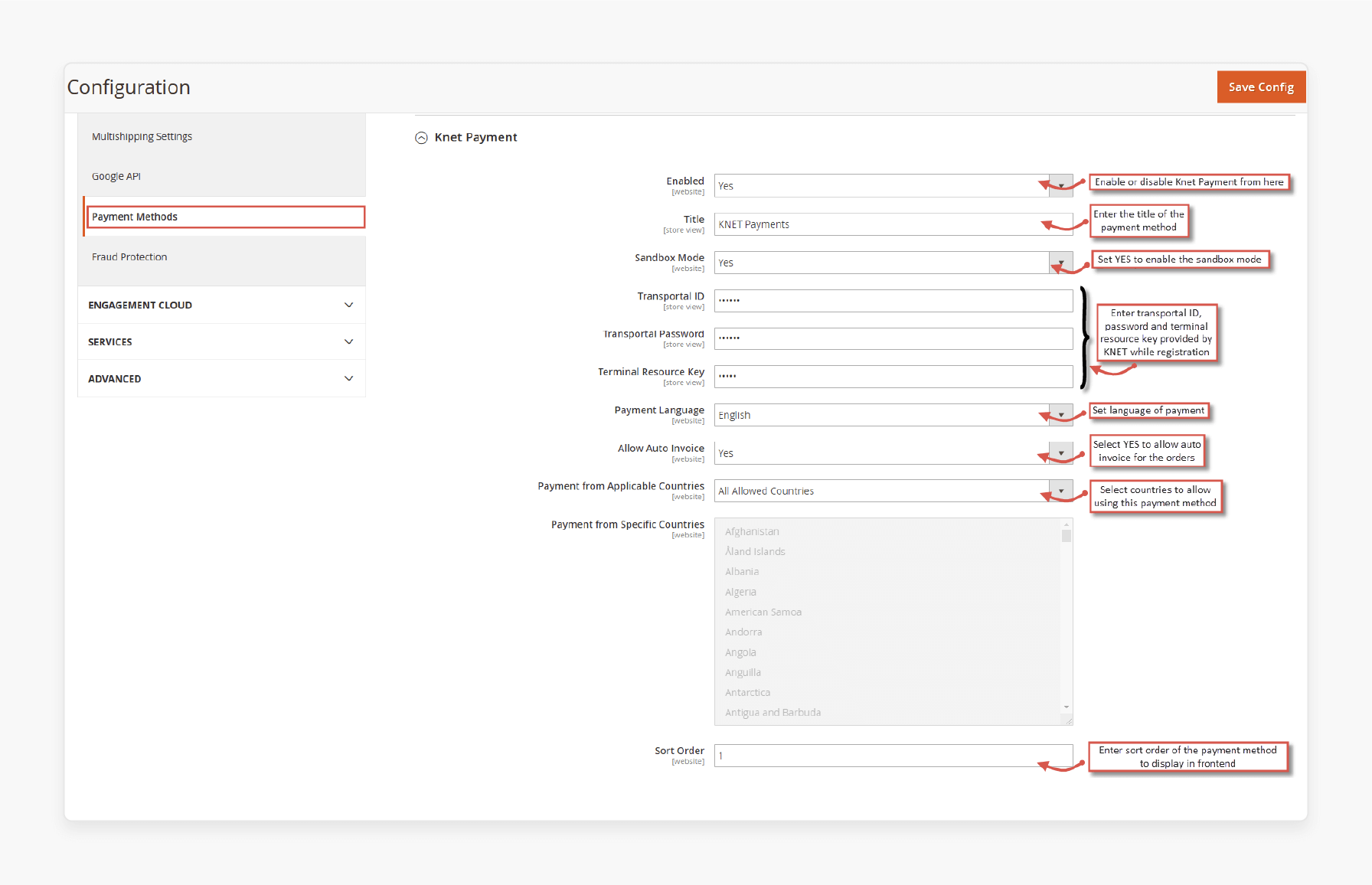
Step 3: KNET Payments in the Frontend
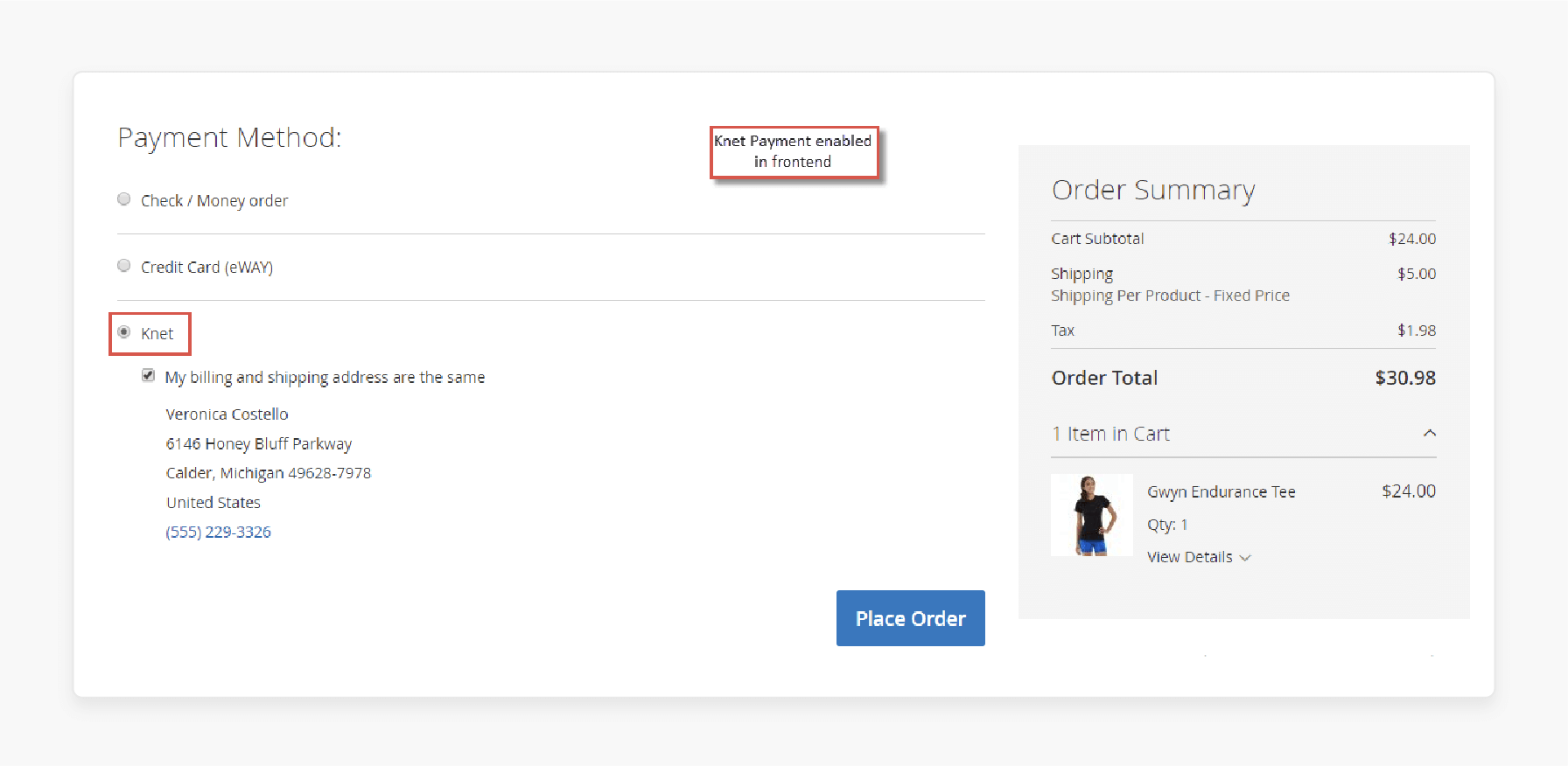
Selecting KNET allows customers to complete payments through the KNET payment gateway. Follow the steps below during checkout:
- Input your card information.
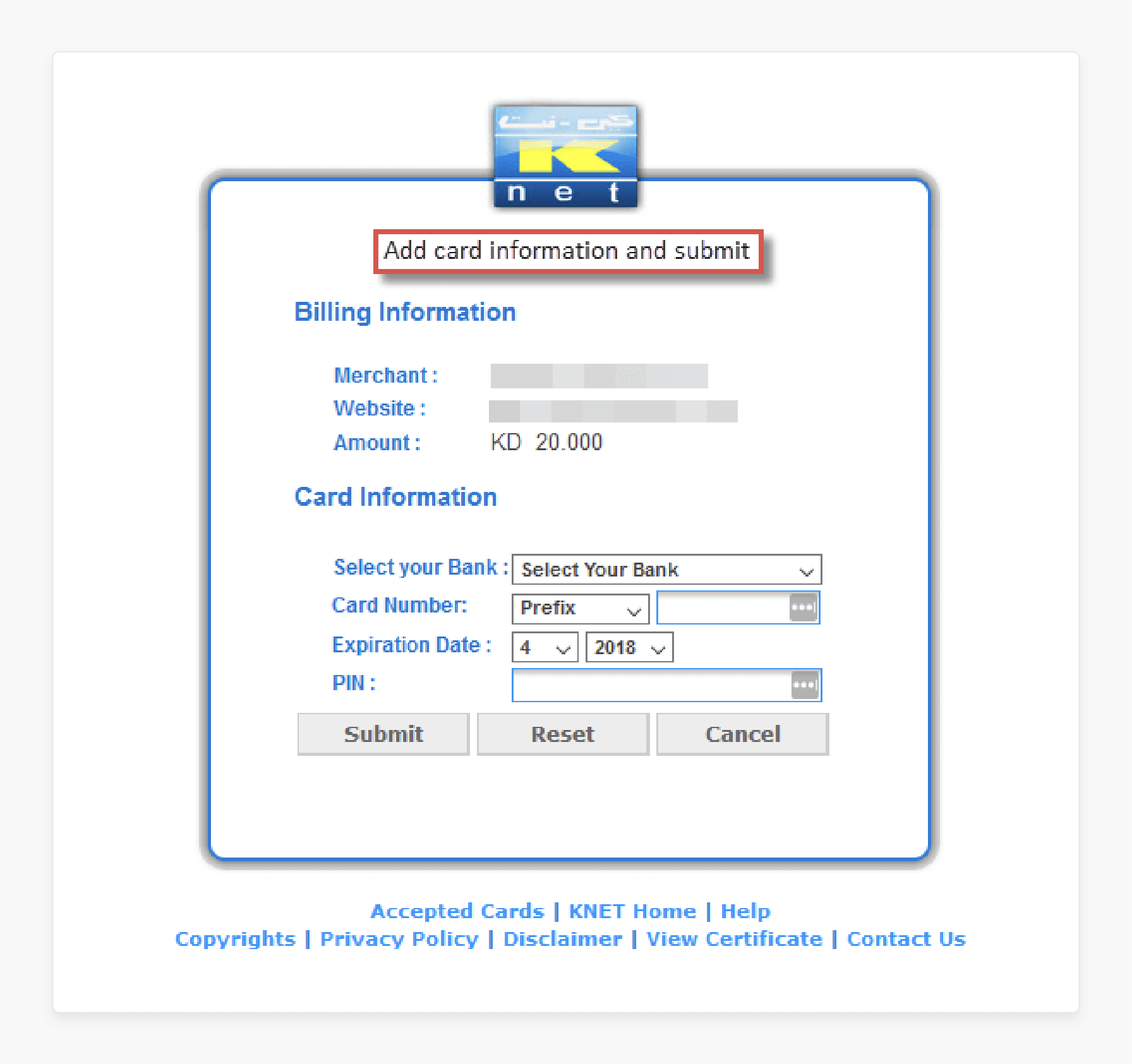
- Click on the 'Submit' button to proceed.
- Click the 'Confirm' button to validate the card details.
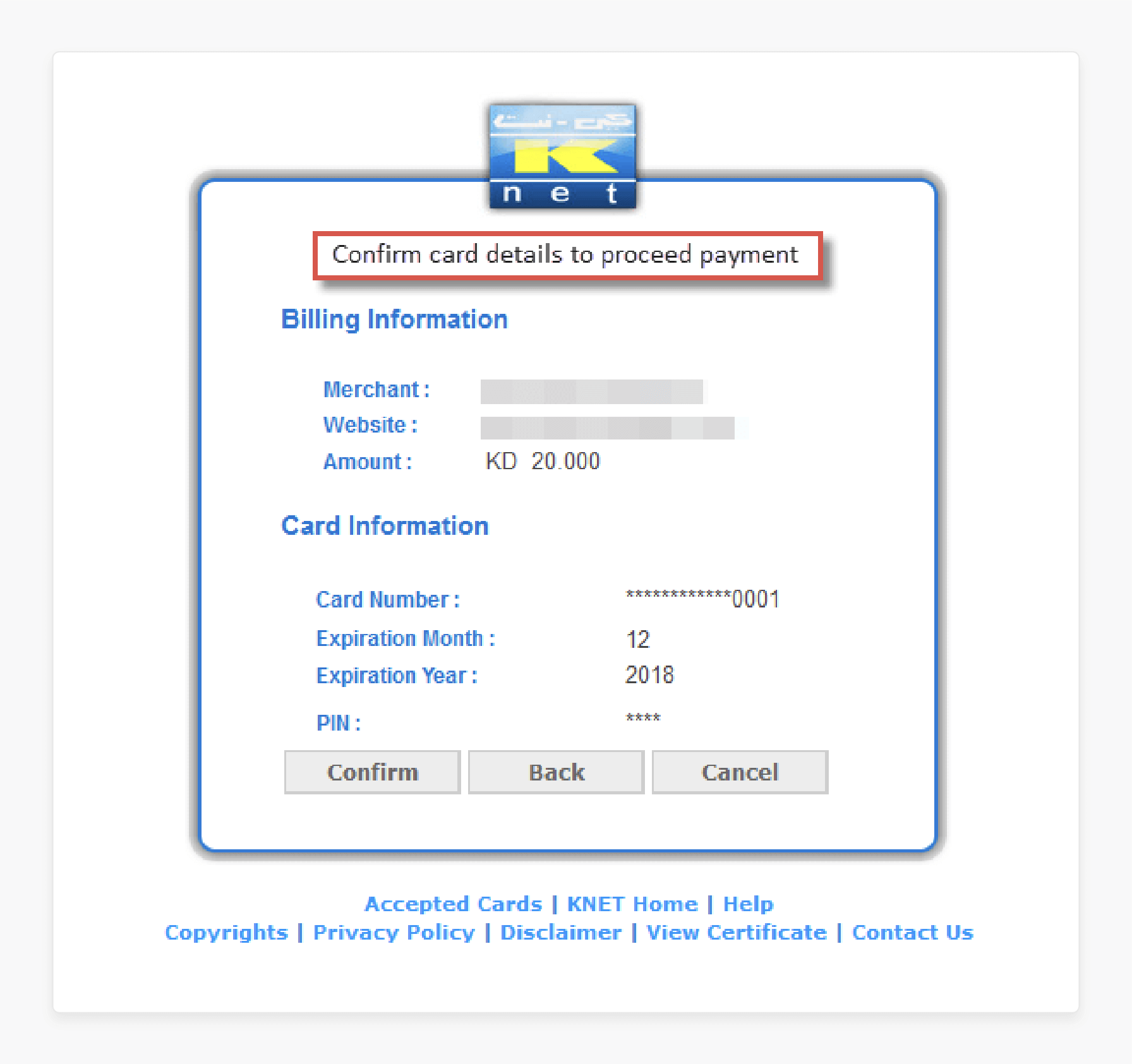
i. KNET Payments in the "My Account" Section
Once an order is placed, payment details are available in the "My Orders" tab of the Account dashboard. These details include:
- Method title
- Payment ID
- Transaction status
- Transaction ID
- Authorization number
- Tracking ID
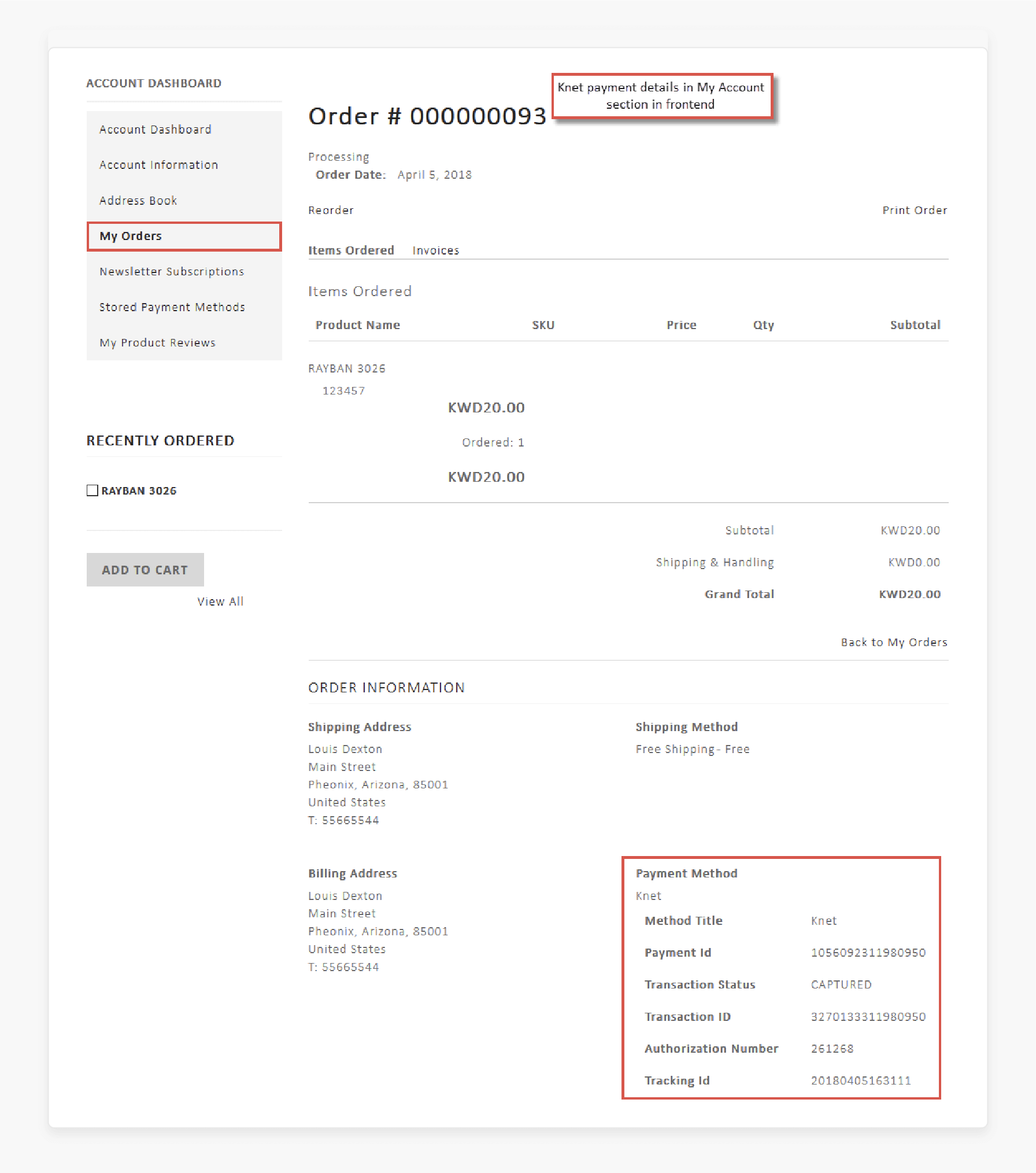
ii. KNET Payments in Order Confirmation Email
After completing an order, customers will receive an email. It includes:
- KNET payment
- Transaction details
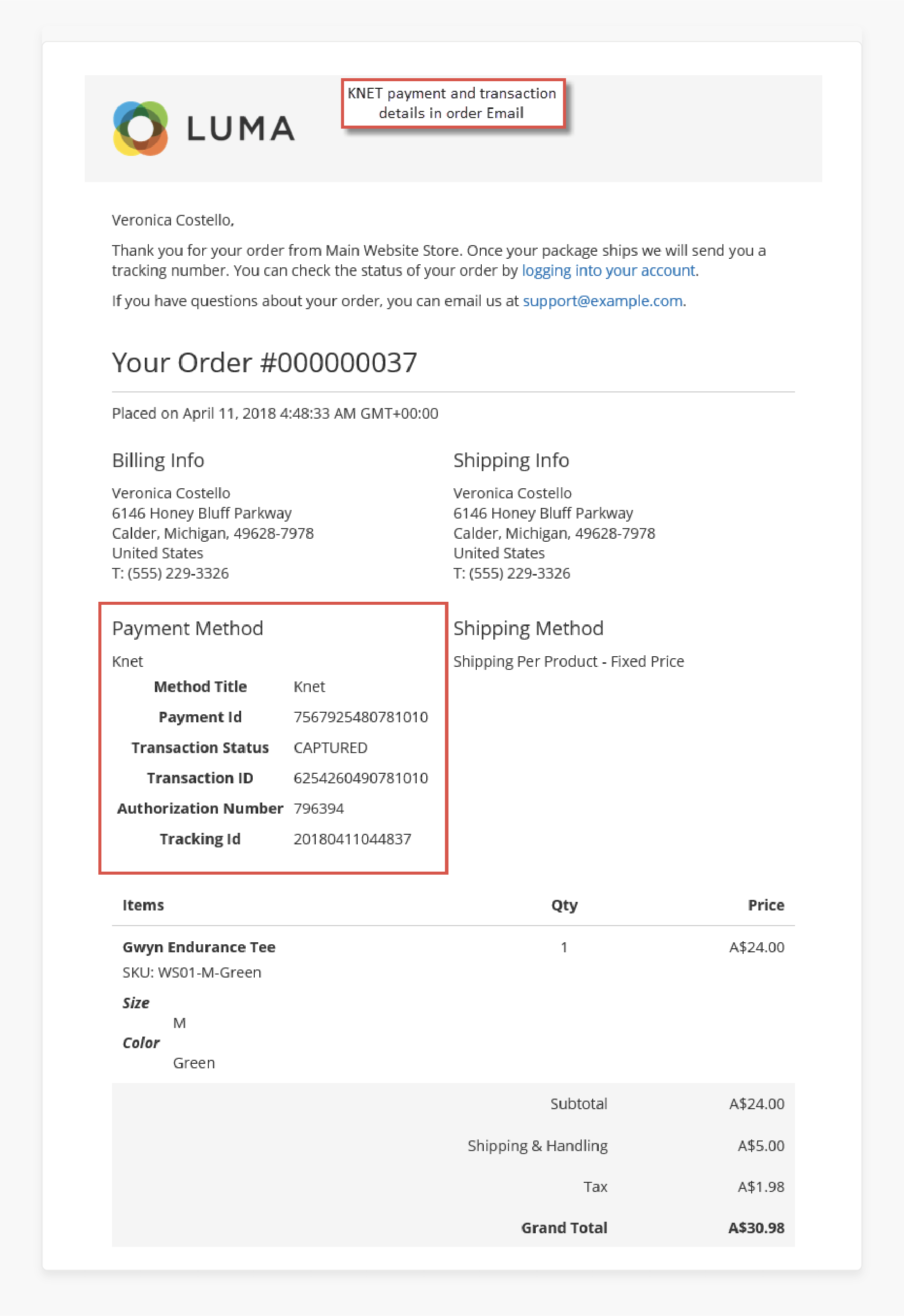
iii. KNET Payments in the Backend
In the 'Order View' section of the admin panel, the payment information is displayed for the administrator. It includes:
- Payment method
- Payment ID
- Transaction status
- Transaction ID
- Authorization number
- Tracking ID
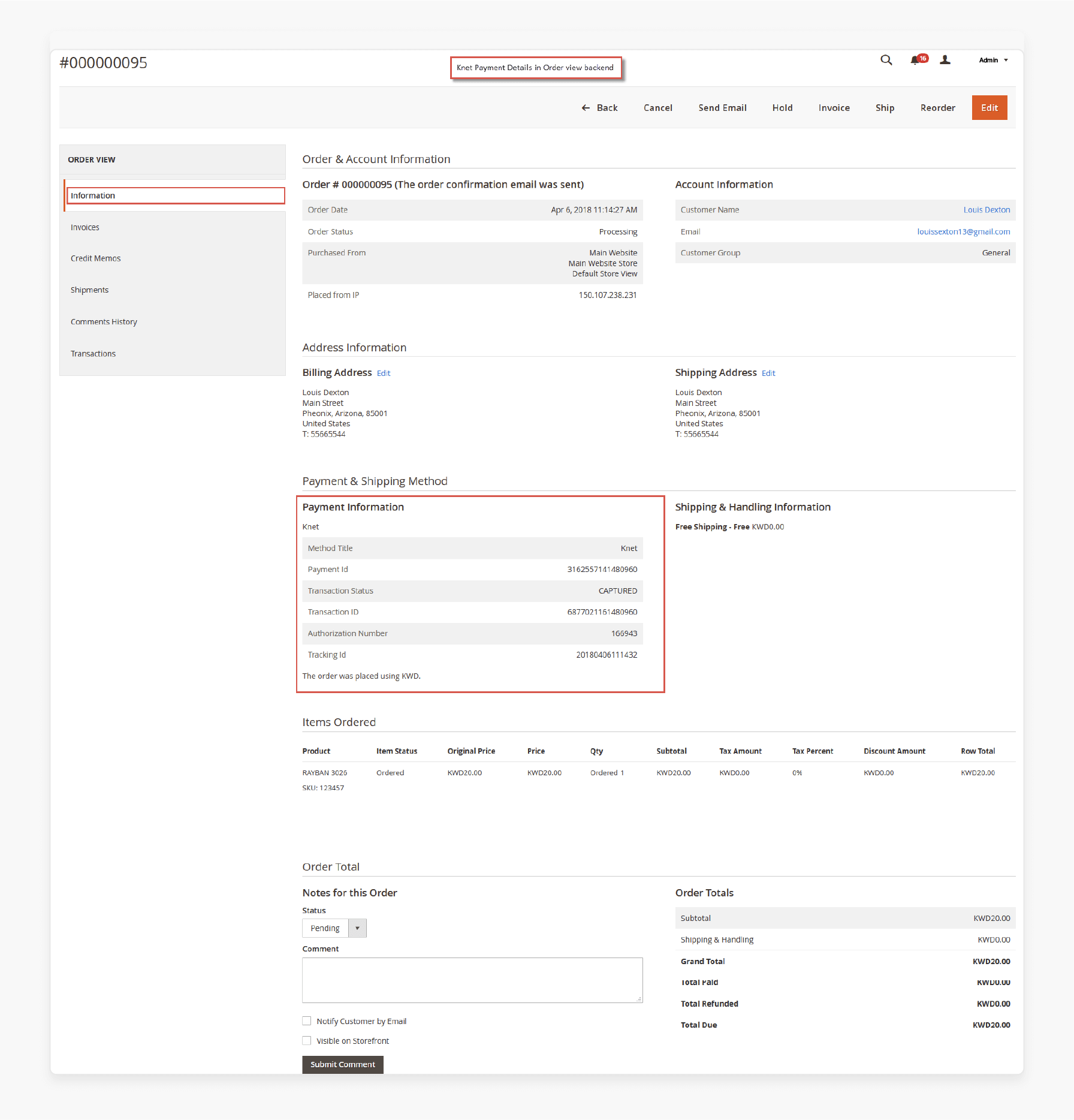
Best Practices For Magento 2 KNET Payment Integration Extension
| Best Practices | Description |
|---|---|
| Check KNET Payment Gateway Logs | - Regularly check the KNET payment detail logs. - Identify any errors or issues. For example, a sudden increase in declined transactions could indicate a problem with your payment gateway configuration. Or a change in KNET's systems that requires your attention. |
| Verify API Credentials | Ensure that the API credentials are correct and up-to-date. |
| Testing in Sandbox Mode | - Test the integration in sandbox mode before going live. - Ensure that it is working correctly. |
| Contact KNET Support | If you are unable to resolve the issue, contact KNET support for assistance. |
| Use a Secure Payment Gateway | - Ensure that the popular payment gateway is secure. - Make sure it is compliant with PCI-DSS standards. |
| Regularly Update Extensions | - Regularly update the KNET payments extension to enable secure payments. - Ensure that you have the latest security patches and features. |
| Monitor Transactions | Monitor transactions regularly to detect any suspicious activity. |
| Use a trusted extension provider | - Use a trusted extension provider. - Ensure that the extension is secure and reliable |
Troubleshooting Common Issues For KNET Payment Gateway With Magento 2
| Error | Cause | Solution |
|---|---|---|
| Payment Gateway Not Redirecting | Incorrect configuration of the KNET payment gateway. | - Ensure that the KNET payment gateway is correctly configured in your store. - Check the API credentials and make sure they are entered correctly. |
| Payment Not Processed | Insufficient funds or incorrect payment details. | - Verify that the customer has sufficient funds and that the payment details are correct. - Check the KNET payment gateway logs for any errors. |
| SSL Certificate Issues | Invalid or expired SSL certificate. | - Ensure that your Magento online store has a valid SSL certificate. - The KNET payment gateway requires a valid SSL certificate in order to process payments securely. |
| Payment gateway timeout | Slow internet connection or server issues. | - Check your internet connection and server status. - Ensure that your server is configured to handle the KNET payment gateway requests. |
| Payment Not Captured | Incorrect configuration of the payment capture settings. | - Verify that the payment capture settings are correctly configured in your store. - Ensure that the payment capture is set to "Authorizeand Capture" to capture payments. |
FAQs
1. How does Magento 2 ensure secure online payments when using KNET?
Magento 2 captures secure online payments on your Magento ecommerce store. It integrates with KNET's trusted payment gateway. When customers complete the payment, they are redirected to the KNET payment page. This process ensures that KNET handles sensitive payment data directly. It reduces your store's security risks. Customers can feel confident knowing that online payments on your store are secured. The process follows industry-standard encryption and security protocols.
2. Why should I use the KNET payment extension in my Magento 2 store for Kuwait-based customers?
The KNET payment extension facilitates the integration of Kuwait's KNET payment gateway into your store. By implementing this extension, you ensure that online payments are fully secured. It builds trust with your Kuwait-based customers. After a successful transaction, the system automatically generates an order email with payment details. KNET is the payment gateway mostly used and preferred in Kuwait. It improves your store's appeal and conversion rates in the Kuwaiti market.
3. What's the process for merchants to start using KNET payments in their Magento 2 store?
Merchants have to go through a setup process to implement KNET. It includes obtaining the necessary API key provided by the gateway. The integration usually takes a maximum of "2 weeks" of testing. It ensures everything works smoothly. KNET was introduced in 2004 to allow secure online payments to be accepted. It completes this testing phase before going live. This thorough process helps maintain high-security standards.
4. How can merchants track KNET payment transactions in their Magento 2 store?
Merchants can easily monitor KNET transactions. They can do this through the order view section in the backend. This area displays detailed information from the acquiring bank. It includes the transaction result and the date from when the merchant received the payment. It helps to verify the status of KNET payments quickly. It is beneficial as a payment method that is widely used and preferred by people in Kuwait. The clear presentation of transaction details helps manage their KNET-processed orders. It also addresses any payment issues promptly.
5. How does the KNET payment extension address security concerns?
The KNET payment extension meets the SAQ A level of PCI compliance. It ensures enhanced security for online payments for products in your Magento 2 store. This high level of security is vital, given the increasing popularity of e-commerce. KNET is preferred by people of Kuwait while making online payments for the products. The extension securely communicates with the acquiring bank with the result. It provides merchants with detailed transaction results. Magento 2 store owners can confidently cater to the growing Kuwaiti e-commerce market. They can help in maintaining strong payment security standards.
Summary
Magento 2 KNET Payment integration is widely preferred for online transactions. It helps store owners:
- Simplify payment collection and SSL encryption.
- Ensure a smooth and safe payment process.
- Efficiently capture payments while ensuring PCI compliance and secure transactions.
- Allow accepting secure online payments effectively.
- Make an informed decision about implementing this payment method.
Consider Magento hosting services to ensure a seamless and safe checkout experience with KNET payment.






